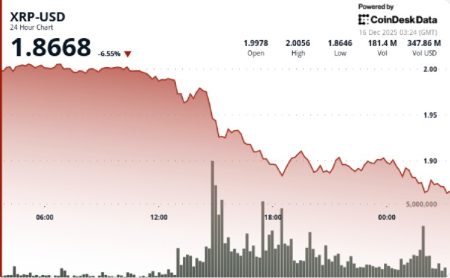Bitcoin’s November Decline: Analysts Lower Year-End Expectations Amid Market Pressure
Bitcoin Faces Unexpected Downturn During Historically Bullish Month
In a surprising turn of events, Bitcoin has continued its downward trajectory into November, traditionally considered a month of upward momentum for the cryptocurrency. Following October’s significant market crash, many investors had anticipated a recovery phase, but those expectations have been dampened as Bitcoin slipped below the critical $100,000 threshold. This continued decline has prompted analysts to reassess their year-end projections and question the timing of Bitcoin’s next substantial rally.
The cryptocurrency market, which often exhibits seasonal patterns, appears to be bucking historical trends this year. November’s performance has particularly concerned investors who rely on cyclical market behaviors for their trading strategies. The current bearish sentiment has intensified discussions among market participants about Bitcoin’s short to medium-term outlook, with many experts now presenting more conservative price targets for the remainder of the year and into 2025.
Long-Term Investors Contributing to Selling Pressure
ShapeShift analyst Houston Morgan has highlighted a concerning trend: Bitcoin has fallen to its lowest level in four months, with long-term investors actively selling their positions. This behavior from typically steadfast holders has intensified the selling pressure across the market. Morgan’s analysis suggests that this is not merely a temporary fluctuation but potentially indicates deeper structural issues affecting investor confidence.
“It will be difficult for the Bitcoin price to surpass $125,000 by the end of the year,” Morgan stated in a recent market report. He emphasized that Bitcoin’s price movement has developed a troubling correlation with U.S. President Donald Trump’s policy statements, particularly those regarding tariffs. “Unless Bitcoin breaks its high correlation with Trump’s policy statements, it will not be easy for it to experience a new bull market,” Morgan added, suggesting that the cryptocurrency needs to establish independence from political influences to regain its bullish momentum.
Critical $116,000 Resistance Level in Focus
According to a detailed analysis from Bitfinex, Bitcoin is currently navigating through a particularly challenging market phase. Their report identifies $116,000 as a crucial resistance level that Bitcoin must overcome to reverse its current downtrend. The analysts emphasize that continued selling by long-term investors—typically the most resilient holders during market turbulence—is creating significant structural pressure on Bitcoin’s price.
“If the Bitcoin price cannot quickly break above $116,000 amidst declining demand, the risk of further declines will increase,” the Bitfinex report states. This assessment highlights a concerning dynamic in the current market environment: upward momentum is gradually weakening, and the longer Bitcoin remains in this stagnation phase, the more investor confidence deteriorates. This deterioration in market sentiment could potentially trigger additional selling, creating a negative feedback loop that further drives prices downward.
Market Stagnation Weakening Investor Confidence
The cryptocurrency market’s current phase of stagnation is proving particularly challenging for maintaining robust investor sentiment. As Bitcoin struggles to regain upward momentum, each passing day of lateral or downward price action erodes confidence in a near-term recovery. Market psychologists have long noted that extended periods of price stagnation can be more damaging to investor morale than sharp, decisive downturns, as they create uncertainty and drain enthusiasm from the market.
This extended period without decisive upward movement has led to increased skepticism about Bitcoin’s ability to reach previously projected price targets. The cryptocurrency’s performance in recent weeks has fallen short of the expectations set during more bullish market conditions earlier in the year. This disconnect between expectations and reality is forcing investors to recalibrate their outlook and consider more conservative scenarios for Bitcoin’s price trajectory through the remainder of 2025 and beyond.
Divided Opinions on Bitcoin’s 2026 Outlook
Looking further ahead, there’s a notable division among market experts regarding Bitcoin’s performance in 2026. Bitwise chief investment officer Matt Hougan has taken an optimistic stance, predicting that 2026 will emerge as a “bullish year” for Bitcoin. Hougan’s perspective suggests that despite current challenges, the fundamental value proposition of Bitcoin remains strong and will reassert itself in the medium term.
Conversely, financial analyst Andrew Lokenauth presents a more cautious outlook. He suggests that 2026 could mark the beginning of a bear market for Bitcoin, potentially mirroring previous mid-cycle downturns in the cryptocurrency’s history. “Historical patterns indicate that Bitcoin may experience a significant cooling period following its next major peak,” Lokenauth explained. “Investors should prepare for a cyclical downturn similar to what we’ve seen in previous market cycles.”
Navigating Uncertainty in Cryptocurrency Markets
The divergent views on Bitcoin’s future highlight the inherent unpredictability of cryptocurrency markets. While technical analysis and historical patterns provide useful frameworks, external factors—ranging from regulatory developments to macroeconomic conditions and even political statements—can significantly influence market dynamics in unexpected ways.
For investors attempting to navigate these uncertain waters, diversification and risk management remain crucial strategies. The current market conditions underline the importance of establishing realistic expectations and avoiding overleveraged positions that could prove devastating during periods of enhanced volatility or sustained downturns.
As Bitcoin continues to mature as an asset class, its correlation with traditional markets and sensitivity to geopolitical events appears to be evolving. This changing relationship requires investors to adopt more sophisticated analytical approaches that incorporate a broader range of variables beyond pure technical indicators or historical patterns.
Conclusion: Recalibrating Expectations Amid Market Realities
The current market environment necessitates a recalibration of expectations for Bitcoin’s performance through the end of 2025 and beyond. While the long-term case for Bitcoin as a transformative financial innovation remains compelling to many, short and medium-term price projections must account for current market realities, including selling pressure from long-term holders and the cryptocurrency’s apparent sensitivity to political developments.
For those with exposure to Bitcoin and other digital assets, maintaining perspective on the market’s inherent volatility is essential. Cryptocurrency markets have historically demonstrated remarkable resilience following periods of decline, but timing such recoveries has proven notoriously difficult even for experienced market participants.
As always, investors should approach the cryptocurrency market with appropriate caution and conduct thorough research before making investment decisions. The insights provided by market analysts offer valuable perspective but should be considered as part of a comprehensive approach to understanding this complex and evolving asset class.
This article does not constitute investment advice. All investments involve risk, and past performance is not indicative of future results.















